Marble Dust Mountain
Oct. 19th, 2023 09:32 pmMy Chinese brushpainting instructor gets irregular leftover chunks of marble from contractors who do marble countertops for fancy kitchens. She grinds them up with a mortar and pestle. She mixes the opaque shimmering marble dust with translucent vegetable pigments to allow light colours to be overlaid on dark colours without the dark colours completely bleeding through. The effect is almost luminous, like clouds of lighter foliage on tree:

Las week in class we experimented with marble dust to create texture, not colour.
The basic idea is to paint a dark background, then to paint a thick paste of marble dust and hide glue (and optionally a little pigment) over it, then once the marble layer is dry, to bend the paper until the marble layer cracks and you can see the background through the cracks. The goal is to get rough, cracked stone. Like this example desolate seascape the instructor did:

My turn! Started with a moody autumnal background (so far so good). You need to use a mulberry fiber paper for this, something with long strong fibers that will stand up to being coated in rock dust and then bent and curled to crack it.

Added the marble dust paste. It should be mixed with glue to be about the texture of melted ice cream. Apply it with an old brush you don't care about very much; it can scrape up the hairs.
I was planning on a stony ridge with a row of autumn-coloured trees on top; the lower "cloud" will be the stone and the upper "cloud" will be leaves. I kind of liked the directionality of this; it seemed like the marble dust pointed strongly towards the center. This bit is still going okay!
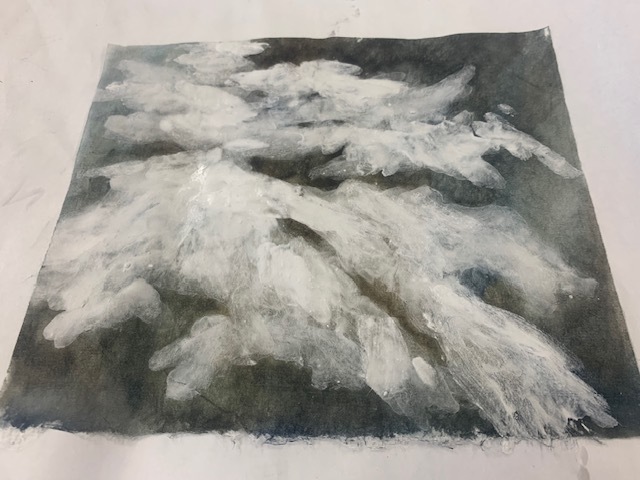
Let it dry, and then curled the paper to crack the marble paste, aiming for more closely-spaced cracking at the top of the ridge. Uh oh. I ended up with chunks flaking off, and not the graceful spiderweb cracking the instructor showed us. I had possibly gotten the ratio of glue to marble dust wrong.
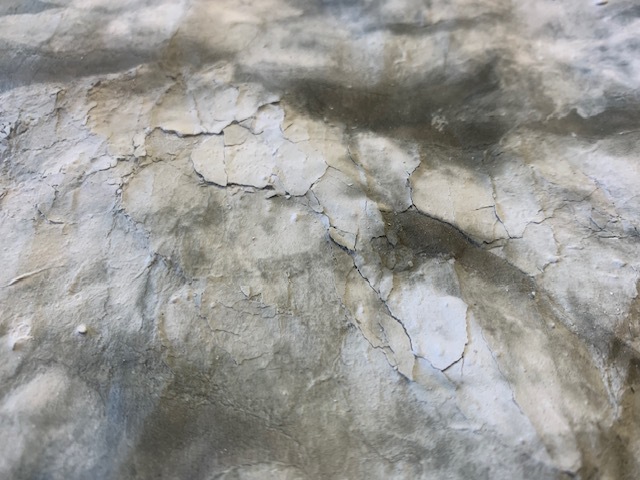
The instructor suggested I go ahead and paint over it - the water in the brush would re-glue some of the pieces down. So I did that, various stone colours, green and brown and grey. This came out nothing at all like I intended, but I think it's genuine fascinating anyway. There's something appealingly dreamlike and desolate about this stage. Some sort of misty moor on which a tragedy will happen.
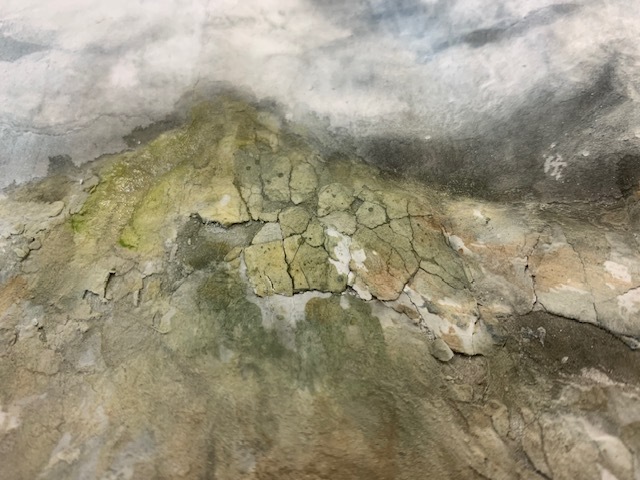
Went on to do the autumn leaves (the top section of marble dust paste, which I hadn't cracked) and the whole thing just looks awful in some way I can't quite explain. It just isn't anything. It's not even bad.
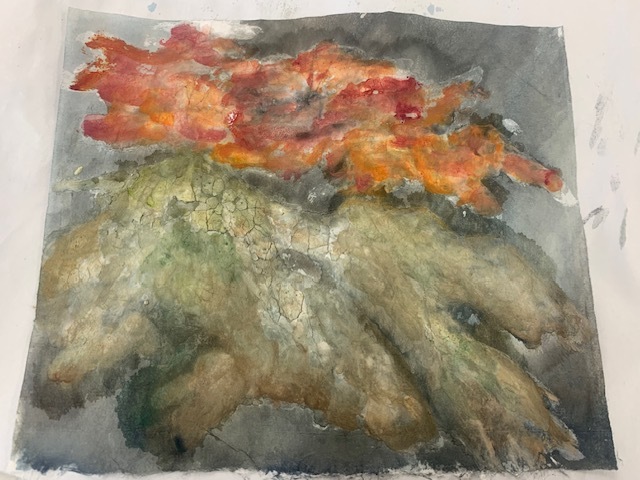
The instructor said I had muddied the colours too much and there were no shadows or depth to anything. Luckily, there's a known solution for that and I already had it in my paint saucer. You can use marble dust with transparent pigment to make pale colours shine over darker ones, like the luminous foliage of the tree at the beginning of this post. So I put down some more marble dust paste.

"Like this?" "More!"

She said to try some bright green on the stone, and bright yellow on in the center of the cloud of foliage. So I did that. I also added another bright autumn tree halfway down the stone and filled in the trunks so it looked less like the two halves of the painting had nothing to do with eachother. It was undeniably better.

But: "Still muddy. Marble dust again!" I put a lot around the bottom tree so it would stand out more.
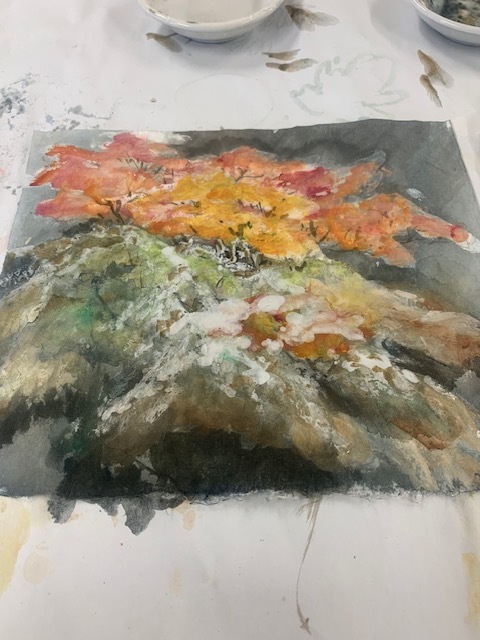
I hated this piece at the end of class. It felt like a Sisyphean ordeal, getting send back to step 2 to reapply marble dust three times. And was it even any better? I had been staring at it and reworking it endlessly and I was thoroughly sick of it. Plus it didn't even have the interesting marble dust cracks we were working on, they'd all been gummed up by endless reapplications of marble dust.
I went home and dropped it on a random flat surface in my office.
The next day I was ... delighted with it. It's bright, it's moody, it's autumnal, it's a little eerie. One of the better things I've painted recently, somehow.
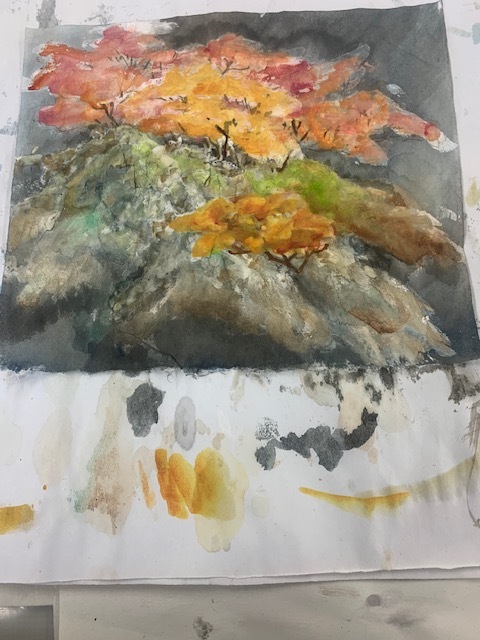

Las week in class we experimented with marble dust to create texture, not colour.
The basic idea is to paint a dark background, then to paint a thick paste of marble dust and hide glue (and optionally a little pigment) over it, then once the marble layer is dry, to bend the paper until the marble layer cracks and you can see the background through the cracks. The goal is to get rough, cracked stone. Like this example desolate seascape the instructor did:

My turn! Started with a moody autumnal background (so far so good). You need to use a mulberry fiber paper for this, something with long strong fibers that will stand up to being coated in rock dust and then bent and curled to crack it.

Added the marble dust paste. It should be mixed with glue to be about the texture of melted ice cream. Apply it with an old brush you don't care about very much; it can scrape up the hairs.
I was planning on a stony ridge with a row of autumn-coloured trees on top; the lower "cloud" will be the stone and the upper "cloud" will be leaves. I kind of liked the directionality of this; it seemed like the marble dust pointed strongly towards the center. This bit is still going okay!

Let it dry, and then curled the paper to crack the marble paste, aiming for more closely-spaced cracking at the top of the ridge. Uh oh. I ended up with chunks flaking off, and not the graceful spiderweb cracking the instructor showed us. I had possibly gotten the ratio of glue to marble dust wrong.

The instructor suggested I go ahead and paint over it - the water in the brush would re-glue some of the pieces down. So I did that, various stone colours, green and brown and grey. This came out nothing at all like I intended, but I think it's genuine fascinating anyway. There's something appealingly dreamlike and desolate about this stage. Some sort of misty moor on which a tragedy will happen.

Went on to do the autumn leaves (the top section of marble dust paste, which I hadn't cracked) and the whole thing just looks awful in some way I can't quite explain. It just isn't anything. It's not even bad.

The instructor said I had muddied the colours too much and there were no shadows or depth to anything. Luckily, there's a known solution for that and I already had it in my paint saucer. You can use marble dust with transparent pigment to make pale colours shine over darker ones, like the luminous foliage of the tree at the beginning of this post. So I put down some more marble dust paste.

"Like this?" "More!"

She said to try some bright green on the stone, and bright yellow on in the center of the cloud of foliage. So I did that. I also added another bright autumn tree halfway down the stone and filled in the trunks so it looked less like the two halves of the painting had nothing to do with eachother. It was undeniably better.

But: "Still muddy. Marble dust again!" I put a lot around the bottom tree so it would stand out more.

I hated this piece at the end of class. It felt like a Sisyphean ordeal, getting send back to step 2 to reapply marble dust three times. And was it even any better? I had been staring at it and reworking it endlessly and I was thoroughly sick of it. Plus it didn't even have the interesting marble dust cracks we were working on, they'd all been gummed up by endless reapplications of marble dust.
I went home and dropped it on a random flat surface in my office.
The next day I was ... delighted with it. It's bright, it's moody, it's autumnal, it's a little eerie. One of the better things I've painted recently, somehow.
